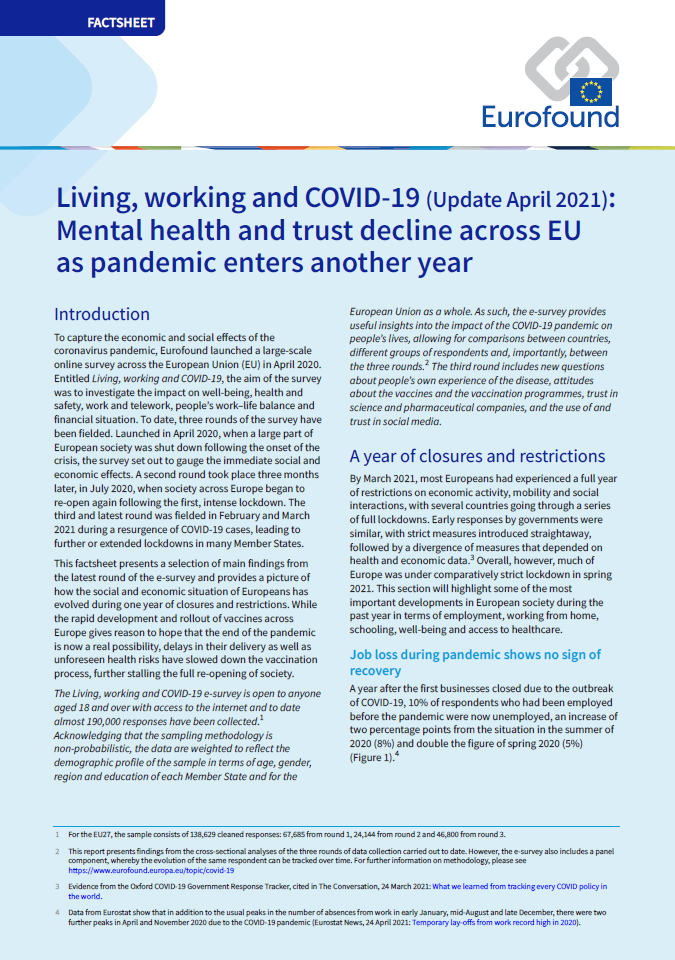
Eurofounds tredje elektroniska enkätrunda, från februari och mars 2021, belyser den sociala och ekonomiska situationen för människor runt om i Europa efter nästan ett helt år med covid-19-restriktioner. I denna rapport analyserar vi de främsta fynden och följer den pågående utvecklingen och de tendenser som ses i EU:s 27 medlemsstater efter det att enkäten först lanserades i april 2020. Rapporten identifierar frågor som har dykt upp under pandemin, såsom ökad otrygghet i arbetet till följd av hot om uppsägning, minskat psykiskt välbefinnande, erodering av nyligen vunna framsteg inom jämställdhet mellan könen, sänkt förtroende för institutioner, ödelagd balans mellan arbete och privatliv och ett groende vaccinationsmotstånd. I resultaten av enkäten betonas behovet av ett helhetsgrepp för att stödja de grupper som har drabbats värst av krisen så att de inte halkar efter ännu mer.
Key findings
Psykiskt välbefinnande har nått sina lägsta nivåer för samtliga åldersgrupper sedan inledningen av pandemin för över ett år sedan. Detta är särskilt tydligt bland ungdomar och dem som har förlorat sitt arbete.
Redan befintliga ojämlikheter ökar på grund av pandemins oproportionerliga effekter på sårbara grupper. Fynden visar att svårigheterna att få ekonomin att gå ihop är avsevärda för dem vars situation redan är svår.
Medborgarnas tillfredsställelse med krisstödsåtgärderna har gått ner och bara 12 procent upplever nu att stödåtgärderna känns rättvisa, jämfört med 22 procent under sommaren 2020. Andelen som fann att stöd erhölls lätt och effektivt minskade också från 16 procent under sommaren 2020 till 10 procent under våren 2021. För nästan en av tio svarande hade en begäran om ekonomiskt stöd blivit avvisad.
Förtroendet för institutionerna har sjunkit kraftigt, särskilt förtroendet för de nationella myndigheterna som föll från 4,6 under sommaren 2020 till 3,9 under våren 2021. Förtroendet för nationella myndigheter i samtliga medlemsstater sjönk under de nivåer som registrerades vid pandemins början. Förtroendet för EU sjönk också, men förblir högre än förtroendet för nationella myndigheter.
Över en fjärdedel av Europas invånare uttrycker tveksamhet inför covid-19-vaccinet, med ett större motstånd bland män (29 procent) än bland kvinnor (25 procent). Vaccinationsmotstånd är också starkt förknippat med låga nivåer av förtroende och användning av sociala medier, där länder som registrerar låga nivåer av förtroende för myndigheter registrerar högre nivåer av vaccinationsmotstånd.
The report contains the following lists of tables and figures. The corresponding data for the tables and figures is available as an Excel download (328KB .xlsx).
List of tables
- Table 1: Location of work and average hours worked during the pandemic, EU27 (%)
- Table 2: Proportion of parents declaring they are too tired after work to do household jobs, EU27 (%)
- Table 3: Proportion of respondents reporting having negative feelings by age and gender, EU27 (%)
- Table 4: Request for support by employment status, EU27 (%)
- Table 5: Proportion of financially fragile respondents by employment status, EU27 (%)
- Table 6: Proportion of respondents reporting difficulties making ends meet by employment status, EU27 (%)
- Table 7: Proportion of respondents reporting arrears by group, EU27 (%)
- Table 8: Trust in the EU by sociodemographic group (mean scores), EU27 (%)
- Table 9: Trust in the national government and the EU by financial support (mean scores), EU27 (%)
List of figures
- Figure 1: Respondents who lost their job (of those who were employed before the pandemic) by country, EU27 (%)
- Figure 2: Preference to work from home post-pandemic, EU27 (%)
- Figure 3: Proportion of parents declaring they would like more online schooling for their children, even when the pandemic is over, EU27 (%)
- Figure 4: Risk of depression by age group and survey round, EU27 (%)
- Figure 5: Unmet need for healthcare during the pandemic by country, EU27 (%)
- Figure 6: Unmet need for healthcare by type of healthcare, spring 2021, EU27 (%)
- Figure 7: Requests for different types of support measures, summer 2020 and spring 2021, EU27 (%)
- Figure 8: Views about pandemic support measures, summer 2020 and spring 2021, EU27 (%)
- Figure 9: Views about pandemic support measures by country, spring 2021, EU27 (%)
- Figure 10: Proportion of respondents reporting difficulties making ends meet by country, EU27 (%)
- Figure 11: Pessimism about financial situation by economic situation, EU27 (%)
- Figure 12: Proportion of respondents stating that their financial situation will get worse, EU27 (%)
- Figure 13: Trust in institutions (mean scores), EU27 (%)
- Figure 14: Trust in the EU by country (mean scores), EU27 (%)
- Figure 15: Trust in national governments by country and survey round, EU27 (%)
- Figure 16: Stated intention to take vaccine by country, EU27 (%)
- Figure 17: Sociodemographic characteristics of people with vaccine hesitancy in Europe, EU27 (%)
- Figure 18: Reasons for vaccine hesitancy, EU27 (%)
- Figure 19: Trust in institutions among people who are vaccine hesitant and non-hesitant, EU27 (%)
- Figure 20: Vaccination hesitancy before and after 11 March 2021, EU27 (%)
- Infographic: Living, working and COVID-19
